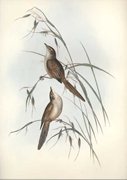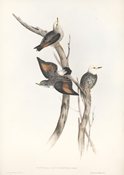Over a period of 50 years, from the age of 26, John Gould published superb hand-coloured lithographs to illustrate birds from different regions of the world. Published between 1840 and 1848, John Gould's Birds of Australia were some of the finest illustrations ever done of Australian birds. Gould published over 3,000 large hand-coloured lithograph plates for his 15 major publications.
In 1909, The Gould League of Bird Lovers was named in honour of ‘the father of Australian birds’ John Gould (1804-1881).



 When he was fourteen John Gould began work as an apprentice gardener with his father in the Windsor Royal Gardens. The British Museum’s zoology collection at Tring in Hertfordshire still contains magpies shot and stuffed by Gould during hisfirst year. After gardening next at Ripley Castle in Yorkshire, Gould went to London and set up business as a taxidermist. His ability was soon recognised, and he stuffed birds for King George IV. The largest unusual commission Gould received was to stuff the King’s much-prized giraffe that had died two years after its arduous journey to Britain as a gift from Mohammad Ali of Egypt.
When he was fourteen John Gould began work as an apprentice gardener with his father in the Windsor Royal Gardens. The British Museum’s zoology collection at Tring in Hertfordshire still contains magpies shot and stuffed by Gould during hisfirst year. After gardening next at Ripley Castle in Yorkshire, Gould went to London and set up business as a taxidermist. His ability was soon recognised, and he stuffed birds for King George IV. The largest unusual commission Gould received was to stuff the King’s much-prized giraffe that had died two years after its arduous journey to Britain as a gift from Mohammad Ali of Egypt.
At the age of 22 Gould was appointed Curator Preserver of the new Museum of the Zoological Society in London. When the Society received a collection of Himalayan birds that had not been described previously, at the age of 27, he began the first of the grand ornithological publications for which he gained worldwide recognition. Gould had an excellent eye for scientific detail as well as colour. He had good business acumen, and enlisted financial support from over 300 of his contemporary naturalists, museums in England and Europe, and from British nobility.



 Aware of his limitations as an artist, Gould encouraged his artistic wife to learn lithography from Edward Lear who from the age of 16 had been working as an artist for the Zoological Society. Between 1831 and 1837, with assistance from Edward Lear after the death of their third child, Elizabeth produced 80 hand-coloured lithographs for A century of birds of the Himalaya Mountains. This series is quite distinctive as the uncoloured habitat backgrounds show clearly the zinc crayon sketching that is used in creating a lithograph. Elizabeth then produced 448 hand-coloured lithographs for Birds of Europe - and John Gould became known as ‘The Bird Man’.
Elizabeth Gould's brothers in Australia, Charles and Steven Coxen, had been sending specimens of Australian birds to John Gould in England. During 1837 and 1838 twenty hand-coloured lithographs were published for The birds of Australia, and the adjacent islands. Gould was not satisfied with these and withdrew them from circulation, and then sailed to Australia with his assistant, English naturalis John Gilbert, Gould's wife Elizabeth, their oldest child who was 7, and a male and a female servant. After arriving is Hobart, Gould and Gilbert travelled around Australia collecting specimens. Elizabeth Gould and their son remained in Hobart, where she gave birth to their sixth child, and worked on her husband's specimen sketches for the lithographic plates that would be made after they returned to England.
Aware of his limitations as an artist, Gould encouraged his artistic wife to learn lithography from Edward Lear who from the age of 16 had been working as an artist for the Zoological Society. Between 1831 and 1837, with assistance from Edward Lear after the death of their third child, Elizabeth produced 80 hand-coloured lithographs for A century of birds of the Himalaya Mountains. This series is quite distinctive as the uncoloured habitat backgrounds show clearly the zinc crayon sketching that is used in creating a lithograph. Elizabeth then produced 448 hand-coloured lithographs for Birds of Europe - and John Gould became known as ‘The Bird Man’.
Elizabeth Gould's brothers in Australia, Charles and Steven Coxen, had been sending specimens of Australian birds to John Gould in England. During 1837 and 1838 twenty hand-coloured lithographs were published for The birds of Australia, and the adjacent islands. Gould was not satisfied with these and withdrew them from circulation, and then sailed to Australia with his assistant, English naturalis John Gilbert, Gould's wife Elizabeth, their oldest child who was 7, and a male and a female servant. After arriving is Hobart, Gould and Gilbert travelled around Australia collecting specimens. Elizabeth Gould and their son remained in Hobart, where she gave birth to their sixth child, and worked on her husband's specimen sketches for the lithographic plates that would be made after they returned to England.



Elizabeth Gould completed over 600 different bird lithographs for her husband's grand publications, and did sketches for hundreds more. Over 80 of the 600 Birds of Australia lithographs were "Drawn from nature and on stone by Elizabeth and John Gould". After her death Henry Constantine Richter completed the lithographs from her sketches, and these lithographs only bear the names J. Gould and H.C. Richter. Elizabeth Gould died following the birth of their eighth child after they returned to England.
Between 1840 and 1869 John Gould published 681 life-like hand-coloured lithographs for The Birds of Australia - and named 328 newly-discovered Australian bird species. No other ornithologist has exceeded the number of discoveries of new birds, - nor exceeded the number of illustrations, or the quality of the illustrations of birds drawn, classified, and published by John Gould (1804-1881) for The Birds of Australia. This was undoubtedly Gould's largest and finest work. (Mammals of Australia with 182 large, hand-coloured lithographs was also published between 1841 and 1863.)



As Gould received later specimens of Australian birds, they were included in The Birds of New Guinea and the adjacent Papuan Islands, including many new species recently discovered in Australia, published between 1875 and 1881. After Gould’s death in 1881, his friend and colleague Richard Bowdler-Sharpe supervised publication until their completion in 1888.
In publishing beautiful hand-coloured lithographs of all the discovered birds of Australia, Gould contributed enormously to general knowledge of Australian ornithology. His hand-coloured lithographs will always be treasured. Original hand-coloured lithographs can be purchased online from AUSTRALIAN nature - Australasian birds, Birds: John Gould lithographs - or if a limited budget, reproductions of some of these from HERITAGE EDITIONS - Birds, including Gould. (Please excuse my inadequate pictures, and feel free to request further pics.)